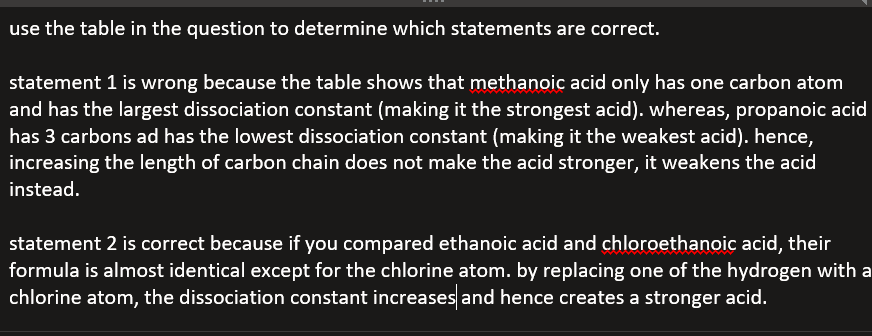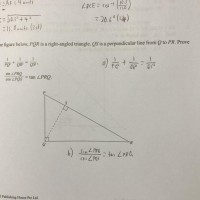Ask Singapore Homework?
Upload a photo of a Singapore homework and someone will email you the solution for free.

Question
secondary 4 | Chemistry
One Answer Below
Anyone can contribute an answer, even non-tutors.

Why is the answer C?
For Q19, we see that from methanoic acid to ethanoic acid to propanoic acid, the dissociation constant decreases. Note that 1.80 x 10^-4 is a 10-fold increase from 1.75 x 10^-5 (essentially standard form).
A decreasing dissociation constant means that the acid gets weaker since less ions are dissociated. Observe that in that order, the number of carbon atoms increases. Hence, an increase in the number of carbon atoms in the chain would lead to weaker acids (at least based on the data) and thus Statement 1 is false.
As for the replacement of hydrogen with chlorine, we compare ethanoic acid with chloroethanoic acid. We cannot use the other acids for comparison because it would not be a fair comparison (two variables are being investigated at the same time).
We see that the dissociation constant of chloroethanoic acid is 1.40 x 10^-3, which is almost 8 times as much as that of ethanoic acid at 1.80 x 10^-4.
As such, based on this information, replacing hydrogen atoms by chlorine atoms would make the acid strength greater, so statement 2 is true.
I suspect the changing of hydrogen to chlorine makes the compound less “organic” and more “inorganic” and hence the behaviour of the acids tends towards the inorganic acids such as hydrochloric acid and sulphuric acid (those acids without carbon atoms).
W, X, Y and Z have increasing proton numbers and are all in Period 3. However, they may or may not be next to one another.
Increasing proton numbers means that W, X, Y and Z are all moving from left to right in the periodic table in that order.
Now, let’s look at the options.
(a) The chloride of Z is ionic.
We cannot say for sure that the chloride of Z is ionic. Based off the Periodic Table, Z must be in group 4, 5, 6, 7 or 0 (since W, X and Y must all be to the left of Z).
All the five possible choices would not make the chloride of Z ionic as Z would be a non-metal. Or in the case of group 0, the chloride does not even exist.
(b) The oxides of W and Z are both ampotheric.
We cannot say this with 100% certainty, because W could be in group 1 (ie sodium) which forms basic oxides and Z could be in group 0 which does not form any oxide at all.
(c) W and Y contain the same number of shell of electrons.
This is true, because this is a property of elements coming from the same period of the table. First period elements contain one electron shell each, second period elements contain two electron shells each and so on.
(d) X and Y could be in the same group in the periodic table.
This cannot be the case, as X and Y are in the same period but have increasing proton numbers. No two different elements can be in the same period and the same group at the same time (like an atomic “fingerprint”).
See 1 Answer





